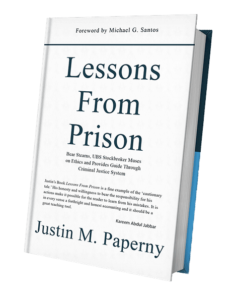What You Need to Know About Halfway House Time and Home Confinement
Everyone serving time in federal prison thinks about the moment they’ll walk out the door and begin transitioning back home. For many, that transition begins with placement in a Residential Reentry Center (RRC)—better known as a halfway house—or through home confinement. But while it might sound straightforward, there’s nothing automatic or guaranteed about getting this placement. In fact, poor preparation can cost you months of liberty.
The Second Chance Act Helped Changed the Game
In 2008, the Second Chance Act created more options for people in federal prison who were ready to return to society. Before the Act, halfway house placements were capped at six months. After the Act, eligible individuals could be approved for up to 12 months in a halfway house and up to six months on home confinement. But the key word here is eligible. The time you get—or don’t get—comes down to how well you prepare.
Jon Gustin, who spent 24 years with the Bureau of Prisons and retired as the Administrator of the Residential Reentry Management Branch, emphasized this point in our interview. He said, “The sooner someone begins documenting their preparation and building a reentry plan, the better positioned they are when decisions are made.” His team oversaw more than 15,000 people in the community and nearly 350 staff members nationwide. Jon’s insight adds credibility to what we’ve long said at White Collar Advice: you don’t get what you deserve; you get what you document and advocate for.
Halfway House Placement Isn’t Guaranteed
The placement process starts when you’re about 17 to 19 months from your projected release date. Case Managers have wide discretion and make decisions based on factors outlined in Title 18, Section 3621(b), including:
- Bed space availability
- The nature of your offense
- Your criminal history
- Sentencing judge recommendations
- Your conduct and programming while in custody
As Jon explained, those who go into team meetings unprepared are at a disadvantage. Team meetings, which occur every six to twelve months, are your opportunity to present a plan and show why you’re ready for community reintegration. If you don’t prepare, someone else will—and they’ll get the placement you thought was yours.
Why Some People Used To Say “No Thanks” To Halfway House Time
Years ago, it was common for some people—especially those with short sentences—to turn down halfway house placement. In camps, life was predictable, and for someone with only a few weeks or months left, it felt easier to ride it out inside rather than transition to a new environment with different rules, curfews, and limitations.
But times have changed.
With the implementation of the First Step Act, turning down halfway house or home confinement is no longer a neutral decision. It’s essentially like turning down a program. The First Step Act incentivizes people to complete evidence-based programs and productive activities in exchange for Earned Time Credits (ETC). These credits can accelerate release dates and increase eligibility for community-based placements like RRCs and home confinement. But refusing a halfway house placement could be interpreted as declining to participate in that continuum.
Jon Gustin reinforced this idea in his interview with Michael. He reminded us that staff and administrators are watching closely. They want to know whether someone is serious about reentry—and willing to do what it takes. A refusal to transfer can send the wrong message.
The bottom line: if you’re earning time credits, why waste them by staying in federal prison?
Understanding the Structure: RRCs, RRMs, and DRCs
Jon broke down an important distinction many people miss. An RRC is the actual facility—commonly called a halfway house. The RRM, or Residential Reentry Manager, is the BOP official responsible for overseeing several halfway houses in a given region. There are 24 RRM field offices across the country. For instance, when Jon served as the RRM for Minneapolis, he managed all RRCs across Minnesota, North Dakota, and South Dakota.
Then there are Day Reporting Centers (DRCs), which are different altogether. The BOP operates only two: one in Memphis and one in Sacramento. Unlike RRCs, DRCs do not provide housing. They’re structured for check-ins and outpatient programming for people who live at home but are still under supervision.
Why does this matter? Because the structure determines your point of contact, who holds authority, and where discretion lies. Knowing who controls what is the first step in effective advocacy.
How to Influence Placement: Start Early and Document Everything
Jon was clear: if you want the best possible outcome, your preparation starts not at the end—but at the beginning. As early as 18 months from your projected release date, the case manager will begin assessing you for community placement. They will evaluate your behavior, your programming, your reentry plan, and your institutional adjustment.
Jon encouraged people to memorialize their preparations early and often. Bring a physical reentry plan to your team meetings. Provide updates. Ask that your narrative be included in the official team meeting report. These reports become part of your permanent record—the very record the RRM, probation officer, and others will review.
“If someone wants to succeed,” Jon said, “they must stop thinking like a defendant and start thinking like a strategic planner. The system responds to preparation.”
Build the Record—Even Before You’re in the System
Jon even encouraged people to prepare for custody before they’re sentenced. If you know you’re going into the system, safeguard your government-issued ID, Social Security card, and birth certificate. That documentation is critical when transferring to an RRC or starting employment. He recommends mailing them to your case manager to ensure they’re part of your file—removing yet another potential delay.
And think long-term. Jon advised imagining the conversations you’ll have three or five years from now. What will you want people to see in your record? What story are you trying to tell?
Probation Officers Carry Real Influence—Start Building the Relationship
Jon was also very specific about the role of probation officers. While the RRM and case managers play key roles, probation officers often influence decisions around work, especially if you plan to pursue self-employment. The BOP is cautious about self-employment—too much room for abuse or inconsistency.
But if your probation officer supports it, and if your reentry plan reflects trustworthiness, you have a shot. That support can be the difference between a “yes” and a “no.”
Jon’s advice? Bring those probation officers into your process. Don’t just meet the minimum—build rapport, show receipts, and show how and why you are “extraordinary.”, like Tracii.
How to Handle Conflict at a Halfway House
We also talked about problems at RRCs. Jon didn’t sugarcoat it. Some staff are inexperienced. Some come from enforcement backgrounds. Some will judge you based on how others have acted. But how you respond matters more than how you’re treated.
He offered a simple script for raising concerns:
“I’d like to discuss something I observed at the halfway house that may have impacted me personally. I want to talk about this situation and learn if there would have been a way that I could have handled it better—or if the staff could have decided differently.”
It’s not confrontational. It’s respectful. And it positions you as someone seeking solutions—not stirring drama.
If that doesn’t work, go up the chain of command—but document everything. Bring supporting policy. Stay calm. And let your body of work do the talking.
Jon reminded us: “These staff members have the discretion to restrict your passes, deny your movement, or grant you near-total liberty. The smart person doesn’t test that—they work within it.” Halfway houses vary in quality—some are converted motels, others dated apartment complexes. Most are co-ed. You’ll likely share space with people coming from all security levels. You’ll follow structured schedules: curfews, drug testing, job verification, daily check-ins, and weekly progress reports.
Jon reminded us that while halfway houses provide more liberty, you’re still in BOP custody. That means everything you do is monitored. The goal, he said, is not just to stay out of trouble, but to show that you can succeed with incremental freedom.
Home Confinement: The Final Transition
Some people move quickly from the halfway house to home confinement. Others go straight to home confinement, depending on eligibility and institutional recommendations. This is where earned time credits (ETC) can help. As Jon shared, ETC doesn’t apply directly to halfway house time, but it can reduce your total sentence. Once you get closer to release, leftover credits may support a move to home confinement.
But remember: discretion is key. As Jon noted, just because a person is eligible for home confinement doesn’t mean they’ll receive it. That decision may also involve the probation officer, the judge, and the RRM. The reentry plan you build—and how others view it—will influence the final decision.
Electronics, Vehicles, and Job Restrictions
Rules vary by facility. Some halfway houses allow smartphones, others do not. Some require approval for vehicles or scrutinize employment with past connections. Jon encouraged people to plan ahead: keep your driver’s license, Social Security card, and birth certificate accessible. Send them to your case manager before transfer. That small step can prevent big delays.
The Case for Self-Advocacy
Jon explained that many white-collar defendants wrongly assume their status or education will earn them special treatment. It won’t. The BOP is structured to assist those who need the most help. That’s why self-advocacy matters. Your background doesn’t entitle you to anything. What matters is whether you built a record that shows consistent, deliberate work toward reentry.
Jon posed a critical question: “What record have you created that would make an RRM view you as ‘extraordinary and compelling’?” If you can’t answer that clearly, you’re not ready.
Problems at the Halfway House? Here’s How to Respond
Halfway houses are not run by BOP staff. They’re contracted facilities with varying standards. Staff may be inexperienced or inconsistent. If you encounter an issue, don’t respond with entitlement. Jon advised diplomacy: calmly explain the situation and ask how it could have been handled differently. Document everything. Escalate respectfully if needed.
That advice echoes something Mick Jagger once said: “You can’t always get what you want. But if you try sometimes, you might find, you get what you need.”
Jon reminded us that halfway house staff have real discretion:
- They can authorize home confinement—or deny it.
- They can approve extended work hours—or restrict you to chores.
- They can grant overnight passes—or cancel them.
Know when to push and when to step back. Strategy matters more than emotion.
Probation Officers: The Hidden Gatekeepers
Jon emphasized that probation officers, not RRMs, often influence decisions about work—especially self-employment. If you want to run your own business or work for family, build a relationship with your probation officer early. Have documentation. Show that others trust you. The more support you have from stakeholders, the more likely your requests will be granted.
The Bureau of Prisons Is in Transition
Jon acknowledged that the Bureau of Prisons is undergoing a period of change. While there have been attempts at reform—through legislation like the Second Chance Act, the First Step Act, and emergency measures such as the CARES Act—there is still considerable inconsistency in how policies are implemented.
Leadership at the top of the BOP has shifted. With recent administrative turnover, it’s unclear what direction the agency will take. What is clear, however, is that people inside the system can’t wait for the institution to figure itself out.
As Jon emphasized, regardless of the state of transition at the BOP, your preparation must remain constant. You can’t afford to wait for consistency. You must adapt, prepare, and build your case for liberty—because no one else is going to do it for you. Your job is to adapt, not wait. You can’t afford to hope the system evolves before your release date.
A Real Example: Tracii Hutsona’s 12-Month Halfway House Placement
One of the clearest demonstrations of how planning can influence outcomes comes from Tracii Hutsona. After being sentenced to 51 months in federal prison—above her plea guidelines due in part to a powerful victim impact statement—Tracii turned her focus from disappointment to preparation.
She worked with our team at White Collar Advice to understand the nuances between what the court says, what her attorney believed, and what the BOP would actually do. With guidance from others who had navigated the same path, she built a release plan that became her roadmap. She shared it with her case manager after surrendering, and that case manager encouraged her to share it with others.
Tracii began teaching classes, mentoring others, and helping fellow prisoners build and update their own release plans. She documented her efforts through blogs, journals, book reports, and consistent engagement with our newsletters through Prison Professors.
When it came time to petition for a sentence reduction, Tracii had a record that spoke for itself. Her judge granted her a reduction, and her case manager—along with the camp administrator—supported her for the full benefits available under the Second Chance and First Step Acts.
Despite not qualifying for RDAP due to staffing issues and an influx of transfers, Tracii still received an 11-month sentence reduction and a full 12 months of Residential Reentry Center placement—an outcome that wouldn’t have been possible without documented, sustained work. As she put it:
“White Collar Advice helped me put together a release plan that I was able to use as an accountability guide throughout my journey… Not only was I granted a sentence reduction by the court, I also was able to show my case manager and camp administrator that I was worthy of the full benefits the Second Chance and First Step Acts offered.”
Her story is a reminder that advocacy isn’t just paperwork—it’s a consistent body of work that others can’t ignore. You don’t earn a full year in the halfway house by accident. You earn it through discipline, transparency, and strategy.
Final Thoughts
If there’s one message Jon reinforced, it’s this: Preparation wins. Not hopes. Not assumptions. A documented, strategic, and consistent plan.
Halfway house and home confinement placement is not something you earn by default. It’s earned by deliberate effort and clear evidence—long before your name is called for release.
Before You Go, Ask Yourself:
- Are you doing the work now that will help someone else make a better decision on your behalf?
- Is there real evidence—something you can hand over—that shows what you’ve done to earn more liberty?
- What would your case manager say about your preparation if asked tomorrow?
If this resonates, join our team this Monday at 1 p.m. Pacific, 4 p.m. Eastern. We host a free webinar to answer questions, share lessons from real cases, and help you avoid the most costly mistakes people make during a government investigation. Bring questions. Come ready to learn.
Justin Paperny




